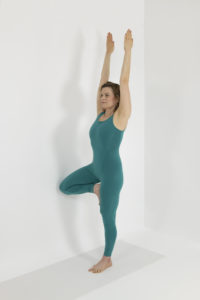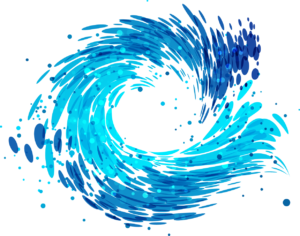
by Nina
As I mention in my post Structural Conditions That Affect Your Knees, bowlegs are a structural condition that affects not only the knees but also the hips and the feet. That’s because people with bowlegs tend to bear weight unevenly on their hips, knees, and feet, with the outer sides of these joints bearing more weight. And this uneven stress and wear on those joints could lead to the early onset of arthritis.
However, although bowlegs is a structural condition, by working with your alignment in your yoga poses, you can learn to bear your weight more even in your asanas and, with that new awareness, in your daily life as well. My long-time teacher Donald Moyer not only taught the students in his teacher training program (the 500 hour training program that I completed) lots of different ways to work with various structural conditions of the knees, but he had bowlegs himself so I was able to learn from him personally about his recommendations for working with this condition and that’s what I’m sharing with you today.
Bowlegged people tend to stand on the outer edges of their feet with their feet slightly turned out and your feet are your foundation in your standing poses (and while you are walking!), so I’m going to begin with some suggestions about the feet. After that, I’ll make some suggestions for working with your legs. If you’re a teacher, you can use these same techniques to help your students with bowlegs.
Working with Your Feet
In Mountain pose (and variations of it), stand with your feet in line with the center of your hip joints, rather than touching each other. This way your legs will be less bowed and you’ll carry your weight a bit more evenly. Then, align your feet by making the second foot bones (the second metatarsal that connects to the second toe) rather than your toes parallel with each other. Once your feet are aligned, consciously bring some weight onto the ball of your big toes and roll your first foot bone (the first metatarsal that connects to your big toe) toward the midline of your body.
In all your standing poses, align your front foot so your second foot bone is parallel with the edge of your mat using the same techniques described above. And for both feet, consciously bring more weight onto the inner edges of your feet, also as described above.
Because people with bowlegs tend to walk on their outer feet, use this new awareness of distributing your weight more evenly on your feet while you move through your day, so you walk on your inner as well as your outer feet.
Working with Your Legs
In your standing poses, after aligning your feet, you should focus on strengthening your inner legs, taking some of the weight off your outer legs. Using props can help you focus on your inner leg muscles.
In Downward-Facing Dog pose (Adho Mukha Svanasana) and Standing Forward Bend (Uttanasana), you can put a block turned on its narrowest side between your upper thighs (and, if you wish, a strap around the thighs to help keep the block in place and give you awareness of your outer thighs). To use this propping in Downward-Facing Dog, you’ll need to place your feet closer together than usual. Then use the touch of the block against your thighs to activate your inner thigh muscles. Use the awareness you develop in these two poses to activate these same muscles in all your standing poses.
You can also use Tree pose (Vrksasana) to help activate your inner thigh muscles, as you press your inner thigh against your raised foot at the same time you press the foot against your thigh. (The version of Tree pose shown above is one that will allow you to really focus on your inner thigh muscles without worrying about balance.)
In standing poses in which you can’t place a block between your legs, such as Extended Side Angle pose (Utthita Parsvakonasana) and Triangle pose (Trikonasana), you can work with a partner. Have your partner stand behind your back foot, and then use a strap around the upper inner thigh of your back leg to gently pull back your inner thigh toward the thighbone.
Because your outer calves are also overdeveloped compared with your inner calves, you can also work on strengthening your inner calves. You can stand with a block between your calves to learn how to activate this area in the same way you did with your inner thighs.
In your everyday life, you can bring this your new awareness of your inner legs into your movements as you walk and go about your day.
In all standing poses, you can bring your legs into a straighter alignment by consciously moving your leg muscles so that the median line of your calves is aligned with the median line of your hamstrings. To do this, move your inner calves toward your inner leg and outer calves toward your outer leg, Likewise, move your inner hamstrings toward your inner legs and outer hamstrings toward your outer leg. How does that feel to you? Is your weight more evenly distributed? You can practice also these same techniques to align your straight leg or legs in seated poses, such as Seated Forward Bend (Paschimottanasana), when you can get a good look at your legs and how your movements affect the alignment.
General Advice About Practicing
In general, with all these suggestions, just experiment and see if any of the techniques feel good to you. For example, many people with bowlegs feel a burning sensation on their outer feet in Widespread Standing Forward Bend (Prasarita Padottanasana). Shifting some of your weight to your inner feet (as described above) may alleviate that pain, making you feel more comfortable in the pose. Sometimes the good feeling you have may be just a sensation of energy moving more freely through you. And if anything causes pain or serious discomfort, please come out of the pose or return to another way of practicing it.
• Follow Yoga for Healthy Aging on Facebook and follow Nina on Instagram • Order Yoga for Times of Change here and purchase the companion videos here • Order Yoga for Healthy Aging: A Guide to Lifelong Well-Being here.


Leave A Comment